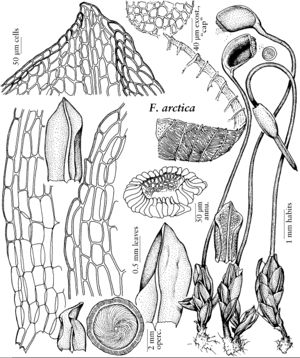Funaria
Sp. Musc. Frond., 172. 1801 ,.
| Taxon | Illustrator ⠉ | |
|---|---|---|
 | Funaria apiculatopilosa | Patricia M. Eckel |
 | Funaria arctica | Patricia M. Eckel |
 | Funaria polaris | Patricia M. Eckel |
Plants small to medium-sized, gregarious or tufted, bright green to yellowish green. Stems short, erect, simple except for a short basal antheridial branch. Leaves larger and erect distally, reduced proximally, oblong-ovate to broadly obovate distally; concave; apex usually acute or acuminate margins erect, entire to serrate beyond middle; costa single, ending before the tip to excurrent; distal and medial laminal cells large, rhombic-hexagonal to rectangular, lax and rather thin-walled, proximal cells oblong-rectangular, differentiated alar cells absent. Sexual condition autoicous; antheridial branches 1–2, basal, perigonial paraphyses clavate with an enlarged inflated cell; perichaetia apparently absent paraphyses. Seta elongate, erect to strongly curved or twisted. Capsule exserted, usually inclined to pendent, asymmetric and usually curved, yellow to brown, pyriform, often sulcate or plicate when dry and empty, annulus large and revoluble or not differentiated, exothecial cells oblong-hexagonal to linear, walls incrassate especially so on inner tangential wall, stomata immersed; peristome double, inserted somewhat below the mouth, teeth well developed, obliquely directed, lance-acuminate, papillose-striate, often strongly trabeculate, frequently appendiculate at the tips and fusing with a latticed disk, endostome segments opposite the teeth, 1/6 or more the length of the teeth, papillose or weakly papillose-striate with a basal membrane and cilia absent. Operculum usually oblique to the axis of the capsule, convex to weakly conic, cells in obliquely radial rows. Calyptra large, cucullate, usually smooth, and often long-rostrate. Spores spherical, smooth or papillose to baccate-insulate.
Distribution
North America, Mexico, West Indies, Central America, South America, Europe, Asia (including Indonesia), Africa, Pacific Islands, Australia
Discussion
Species ca. 200 (9 in the flora).
Funaria comprises mainly small to medium seasonal mosses growing on moist mineral or peaty soils in strong light. For the most part, they are relatively short-lived pioneer species adapted to complete the life cycle by producing many spores quickly, in a cool, moist, bright (but not sunny for long periods), exposed, disturbed habitat. In North America, the best time to look for members of the family is spring before the soil dries out. The most common species can be recognized by the production of large numbers of sporophytes bearing a double peristome with inner and outer teeth opposite rather than alternate as is typical for most mosses. The teeth tend to be torqued in one direction with the tips of the exostome adhering weakly to a few-celled disk. Because the sporophyte shows more morphologic diversity than the gametophyte, it is often essential for identification. H. A. Crum and L. E. Anderson (1981) discussed the indistinct generic limits between Funaria and Entosthodon and the application of generic names.
Selected References
Lower Taxa
Key
| 1 | Annulus absent | > 2 |
| 1 | Annulus large, revoluble | > 5 |
| 2 | Distal leaves with a long, flexuose, excurrent costa with a hyaline tip. | Funaria apiculatopilosa |
| 2 | Distal leaves acute to narrowly acuminate, costa percurrent or, if excurrent, straight and concolorous | > 3 |
| 3 | Leaves with acute tips, distal marginal cells serrate from a series of elongate blade cells. | Funaria serrata |
| 3 | Leaves with acuminate tips, marginal cells not different from the blade cells | > 4 |
| 4 | Costa ending in a narrowly acuminate tip or excurrent, endostome segments broadly triangular proximally and nearly as long as the exostome teeth, east of Rockies. | Funaria americana |
| 4 | Costa ending before the slender, filiform acumination, endostome segments narrowly lanceolate and about 2/3 the length of the exostome teeth, western states. | Funaria muhlenbergii |
| 5 | Endostome segments lanceolate, slender pointed, at least 2/3 the length of the exostome teeth | > 6 |
| 5 | Endostome segments narrow, less than 1/2 the length of the exostome teeth, or rudimentary | > 7 |
| 6 | Seta strongly twisted and hygroscopic, 20-80 mm, capsule with an oblique mouth sometimes almost parallel to the axis of the capsule, leaves acute to acuminate, often with a short excurrent costa. | Funaria hygrometrica |
| 6 | Seta curved to cygneous, 8-12 mm, capsule mouth scarcely oblique to the axis of the capsule, leaves broadly acute to obtuse, costa ending before or in the tip. | Funaria arctica |
| 7 | Capsule symmetric or nearly so, seta strongly curved, axis of the capsule aligned with the seta. | Funaria polaris |
| 7 | Capsule curved to nearly straight, horizontal to pendent from the seta | > 8 |
| 8 | Capsule nearly straight and cylindrical, mouth 2/3 or more the diameter of the capsule, leaves tending to be broadly oblong-ovate. | Funaria flavicans |
| 8 | Capsule curved and pyriform, mouth 1/2 or less the diameter of the capsule, leaves tending to be oblong-lanceolate to oblanceolate. | Funaria microstoma |